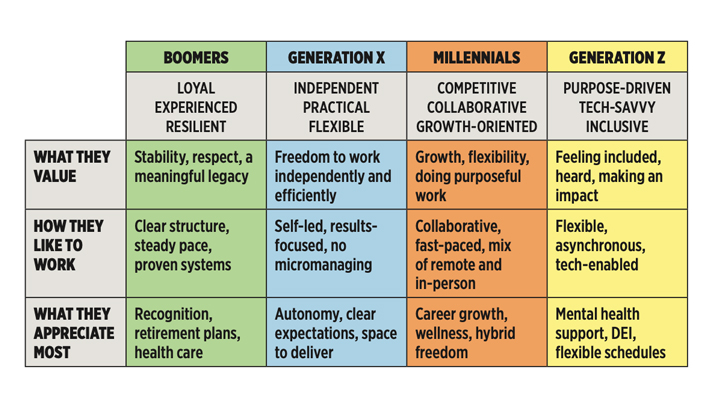Navigating generations: How to lead a team of workers of all ages
Today’s workforce has different faces in it compared to any other time in our country’s history. People are staying healthier longer, and for personal and economic reasons, they are choosing to remain in the workforce.
This shift puts the United States in a unique position of having four distinct generations actively working. Walk into almost any business and you’re likely to see representatives of the baby boomers (born 1946-1964), Generation X (1965-1980), Generation Y/millennials (1981-1996) and Generation Z (1997-2012) working side by side. Of these generations, millennials and Gen Z are the largest and fastest-growing, and will make up 75 percent of the workforce by 2030.
Leaders must understand the best way to engage a workforce built around the layers of generations, each with their own defining characteristics, values and attitudes shaped by the formative events of their time. Let’s also remember that although each group has its differences, there are also commonalities across generational lines that must be considered.
First, it is important to understand a few aspects about each generation. The chart here includes facts about each generation. You will notice several differences among the generations.

Despite the differences among the generations, there are some common threads that connect these generations:
⦁ Desire for connection: While methods vary, all generations seek connection and meaningful conversations, whether in personal life or the workplace.
⦁ Feedback wanted: All generations want feedback in a slightly different way. Boomers prefer scheduled reviews, while Generation X likes straightforward feedback that is tied to outcomes. Millennials prefer frequent coaching-style conversations, and Generation Z likes quick, clear and casual feedback.
⦁ Adaptation to technology (to varying degrees): While older generations may have adopted technology later, each has had to adapt to evolving technological landscapes to some extent, even if their comfort levels and preferred uses differ greatly.
⦁ Seeking purpose (especially in work): While boomers have found purpose in career achievement, younger generations (millennials and Gen Z) explicitly seek purpose and meaning in their work that aligns with their values.
Trust is an important aspect of workplace culture. To nurture trust across the generations, pay attention to what breaks trust with each generation:
- Boomers – Being micromanaged or sidelined
- Generation X – Slow processes, too many rules
- Millennials – No feedback or growth plan
- Generation Z – Rigid rules, no voice, being overlooked
At the end of the day, regardless of an employee’s generation, all employees want their voices to be heard, and they want to do work that matters. When we recognize our employees not only for what they can do for us, but for who they are, they can and will move mountains. If in doubt, lean on curiosity to better understand an employee and what motivates them, or how they need you to show up for them.
Do not be afraid to ask the question, “How can I be better for you?”
You will receive useful feedback, and you will also let your employee know that they can ask you the same question.
Kelly Bosak is the chief people officer at Lettermen’s Energy, where she leads a small but mighty HR team supporting Lettermen’s employees nationwide. Kelly can be contacted at kelly.bosak@lettermensenergy.com or 816-679-1105.
Homepage featured image: A-Digit/DigitalVision Vectors/Getty Images
Related Articles
Propane retailers: How different generations approach workplace safety
Research: Millennials present a promising demographic for the propane industry
What separates companies that are succeeding in recruitment from ones that aren’t?
















